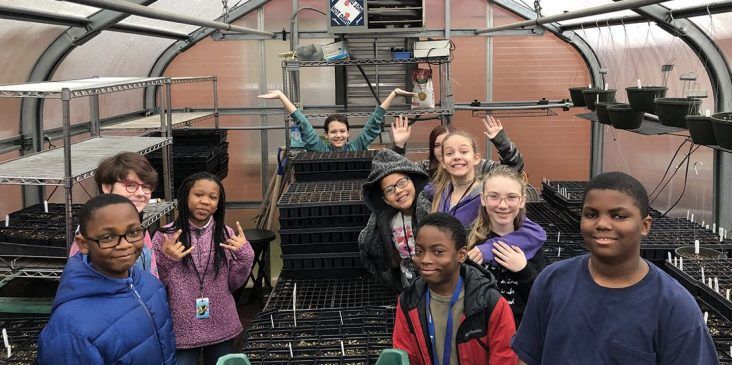Jonesboro Public Schools blend unique magnet schools, academies throughout district
by August 14, 2019 5:17 am 1,389 views

Jonesboro Public Schools students check out the greenhouse at one of three academies.
When Jonesboro Superintendent Kim Wilbanks took over the school district about a decade ago, she wanted to find ways to innovate the way the district educated its students.
The district has successfully implemented its elementary magnet school system. Once the five magnets were established, the high school was changed into a series of academies, Jonesboro assistant superintendent William Cheatham told Talk Business & Politics.
“We looked around at our community to see what was the best fit,” he said. “It gave us a lot of new energy.”
The Jonesboro School District (JPS) is the largest district in Northeast Arkansas and one of the largest in the state. Founded in 1899, the district has more than 6,600 students. The district is landlocked, but that’s not stunting its growth. JPS is projected to grow by 18% (1,159 students) during the next 10 years. If current projections hold, the district will be operating above capacity in all of its buildings within the next five years.
When the idea of magnet schools was first discussed and later the academies, school officials decided to visit other cities in the state that had enacted some form of these schools, Cheatham said. Visits were made to Hot Springs, Texarkana and Mountain Home. Cheatham isn’t sure if any other district in the state blends the magnets and academies the way JPS does.
“It’s a pretty unique thing,” he said.
JPS has five elementary magnet schools. Those schools are health, wellness, and environmental studies; international studies; math and science; microsociety; and visual and performing arts. Students are allowed to choose which magnet they prefer and can switch if it’s not a good fit.
Health and Wellness allows students to maintain vegetable, butterfly, and flower gardens as part of the curriculum. It has a bio-lab that features birds, rabbits, frogs, turtles, snakes, a gecko and ferret. The magnet also has a nutrition lab. The International Studies magnet offers weekly Spanish instruction and is premised on project-based learning. Each grade represents a different continent and students are immersed for the entire school year in that theme.
Math and Science offers a lot of technology courses, a broadcasting studio, numerous school clubs including robotics and a breakfast book club. The curriculum is multifaceted and teaches students how to solve problems different ways.
Microsociety blends economics, citizenship, government, humanities, arts and ethics in its curriculum. Students choose a job or a business to attend daily. The magnet has a chamber of commerce and it includes a mayor, bank, post office, judicial system and small businesses. Visual and Performing Arts incorporates drama, art, music, dance, into its curriculum each week. Suzuki violin, African drum and digital piano lessons are given. The magnet produces two musicals each year. It also offers after school arts-oriented workshops.
JPS offers a series of preview nights to help parents decide which magnet will work best for their child, Cheatham said.
When students complete their elementary school magnet training, they are funneled into the district’s two middle schools, Annie Camp and Douglas MacArthur. After completing the ninth grade, students have another choice to make — which JPS high school academy they want to attend.
The district’s academy program is one of the few in the state. School administration officials studied Mountain Home’s academy programs, and once again, administrators analyzed what would be the best fit in terms of what the community wanted and needed for the school district.
Business, Communication Arts, and Law (BCAL); Health and Human Services (HHS), and Science Technology, Engineering & Math (STEM) were the three academies that were formed by the district.
BCAL incorporates visual media, digital communications, computer business applications, financial literacy, accounting skills, law and work-based employment skills into its curriculum. Some of the coursework in the academy provides students with industry certification, making them more employable after graduation. Other courses offer employment skills training that students encounter in the real world of business. Visual media and digital communications courses provide students with publishing and design skills for print and digital media. Financial literacy and accounting coursework provide students with skills relevant to the financial aspects of business.
Students interested in the fields of food & natural resources, education, government, health science, hospitality and tourism, and human services attend HHS. Teachers and students explore these careers with the goal of improving the lives of others locally and internationally. Teachers in this academy foster skills such as resource allocation, team management, adaptability, systems evaluation, effective communication, and many more that can easily transfer into a work-related environment. Students in this academy learn what it means to be active participants in their community, productive citizens of their country, and caring advocates for human rights around the world.
STEM provides an integrated curriculum of Science, Technology, Engineering, and Mathematics to help students become college and/or career-ready by learning to reason and think creatively and critically in order to solve real work problems. In this academy, the students will be engaged in rigorous academic work that will require a mindset of growth and effort with a heavy emphasis on math and pure science.
One of the main problems with allowing students to attend different schools within the district was busing, Cheatham said. It took several years to form a system that worked and it involved changing school start and let out times, he said.
During the next decade, the school district anticipates rapid growth. The district adds at least 100 new students a year and the district is running out of space, he said. But, robust student growth is a good problem to have and it’s one of the reasons the magnets and academies have been so popular and successful, he said.
“We want to capture the hearts and minds of our students,” Cheatham said.
